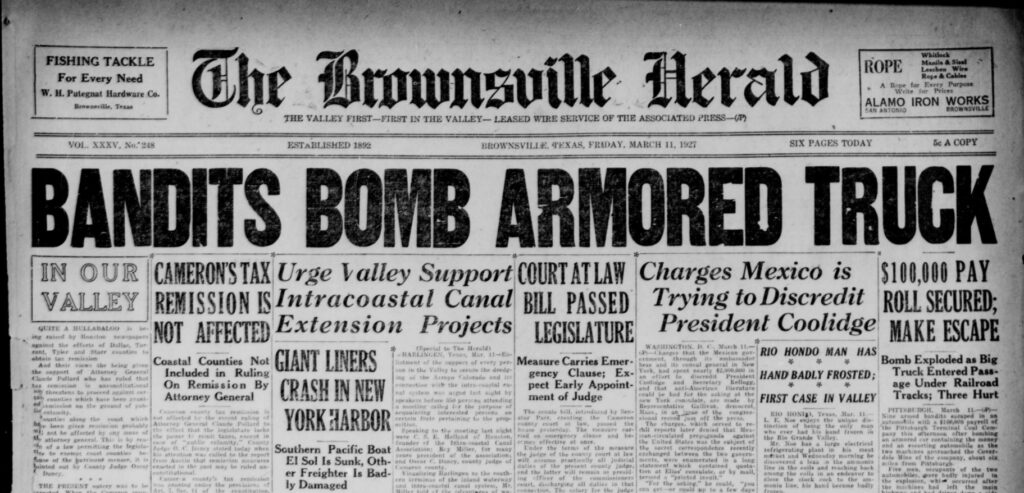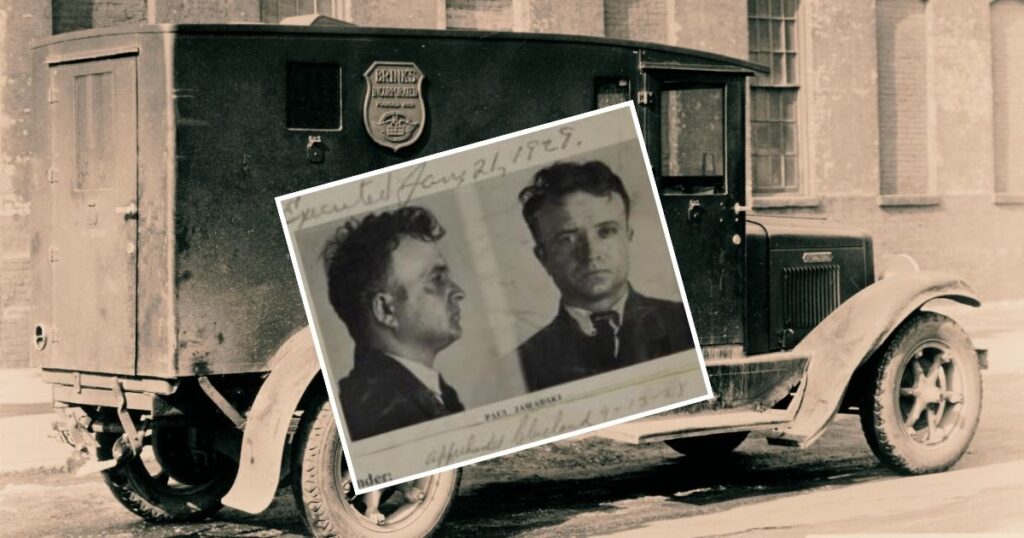1927 was remarkable for technological firsts. Charles Lindbergh made the first solo non-stop transatlantic flight from New York to Paris. Philo T. Farnsworth transmitted the first electronic TV image. Warner Bros released The Jazz Singer, the first feature-length film with synchronized sound.
On the crime front, Paul Jaworski and the Flathead Gang advanced the science of payroll robbery by using explosives buried under a road to commit the first U.S. armored car robbery about 10 miles south of Pittsburgh.
On March 11, William Tarr was driving a Brinks armored car carrying the payroll for the Pittsburgh Terminal Coal Company’s Coverdale mine. Two guards were in the truck with him, and two more following in a car behind. Around noon, they turned off the main road onto old Bethel Road. None of them knew it, but they were about to go on the ride of their lives.
There were two stacks of newspaper beside the road about 30 feet apart. When the armored car drew even with the second stack 100 yards away in the woods, one of the gang touched two wires to a battery hidden in a hollow stump, triggering the two charges of dynamite they had buried under the road.
The earth erupted, and the armored car catapulted into the air, flipped upside down, and landed on its roof. All three men inside were knocked unconscious. The second charge went off in front of the guard car, but it plowed into the four-foot crater, and the crash rendered the guards senseless.
Jaworski and company hustled out of the woods and ran to the overturned armored car. They found the rear doors broken open and hurriedly began unloading bags of cash. They made off with more than $104,000.
Tarrr regained consciousness and crawled, bleeding out of the wreckage. One of the gang ordered him facedown in the dirt. He was able to get a look at some of the gang and one of the two getaway cars. Somehow, all of the guards survived. One suffered a fractured skull.
The gang had done their homework well. They knew the route and the timing of the payroll delivery. To slow pursuit, they had even cut the phone lines in advance.

Suspicious Circumstances
Unfortunately for Jaworski, his getaway plan fell flat. That is to say, the stolen car, a blue Stearns Knight, they were driving blew a tire, and they were forced to push it into the woods and proceed on foot to a nearby farm they had been using as a hideout as they planned the caper. The police found the car and were able to trail them to the farm.
Jaworski was questioned for several hours. He gave them a fake name, John Smith, and claimed to have no knowledge of the holdup. The cops weren’t buying it. They asked him to explain some of the items they found at the farm, including a half box of dynamite, four shotguns, $67 in new bills, his .45 caliber revolver, and a Detroit bankbook, which showed a $5,000 deposit two weeks after a holdup in Mollenauer, PA.
If Jaworski had been caught with a Wile E. Coyote-style blueprint showing the Brinks cars, the road, the bombs, an anvil, and the Road Runner, he would have looked less guilty.
Using a fake telegram from one of Jaworski’s accomplices, they tricked him into confessing to both the Mollenauer and Coverdale robberies. He even led them to $33,000, which he had buried in a milk container in a manure pile on the farm. I mean, it was the last place I would have looked.
A payroll guard named Isaiah Gump had been killed during the Mollenauer holdup, and Jaworski was convicted of his murder.
Jaworski was being held in the Allegheny County Jail awaiting sentencing for the robbery and murder when, on August 18, his brother Sam paid him a visit and smuggled in four .45 caliber revolvers. Bullets rang off iron bars as Paul, Sam, and another prisoner, John Vasbinder, shot their way out of the jail, wounding two policemen.
On September 13, 1928, Jaworski and Vasbinder were spotted at a restaurant in Cleveland. Another gunfight ensued, and Jaworski killed a policeman, bringing his number of victims to at least seven. He was wounded in the firefight and partially paralyzed.
On January 21, 1929, at Rockview Penitentiary, Jaworski was executed in the Pennsylvania electric chair. As the Roaring 20s drew to a close, so did the life and career of a gang leader, master thief, and brutal killer.
If you enjoyed this story, please consider sharing it with a friend or clicking on one of the social sharing icons above or below the post. Comments are always welcome. If you have a topic or crime you’d like to see covered, email me at editor@blueridgetruecrime.com.
Check out my new book, Blood on the Blue Ridge: Historic Appalachian True Crime Stories 1808-2004, cowritten with my friend and veteran police officer, Scott Lunsford on Amazon. Buy it here!
I also have a Substack newsletter, A History of Bad Ideas, where I write about poorly thought-out ideas, misguided inventions, and dire situations throughout history created by people who frankly should have known better.
Sources
Morning Herald, Uniontown, PA, Saturday, March 12, 1927, “Bandits Wreck Armored Autos Near Coverdale”
News-Herald, Franklin, PA, Monday, March 14, 1927, “Police of Eight Cities Watch for Payroll Bandits”
Pittsburgh Post, Monday, March 14, 192, Page 1, “Gang Safely Started for Detroit is Police View”
Pittsburgh Press, Wednesday, March 16, 1927, Page 1, “Confession Starts Hunt for Four Other Robbers”
The Sentinel, Carlisle, PA, Friday, August 19, 1927, “Offer $15,000 for Bandits and Ally”
New York Times, Friday, September 14, 1928, Page 22, “Jaworski Trapped Kills One Pursuer”
Detroit Free Press, Tuesday, January 22, 1929, Page 1, “Jaworski Pays Death Penalty”
Pittsburgh Post-Gazette, Wednesday, March 10, 2021, Page C1, “Explosive History”

